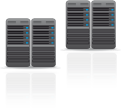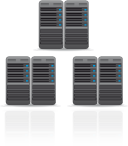-
 Dual
Dual- Two combined App/DB servers
- Complete redundancy of app and DB
- HA-Load Balancing and HA-Storage
- No Single Point of Failure (SPOF)
- Simple and flexible scalability with additional servers
- Flat rate support inclusive
- Monitoring and backups inclusive
- Excellent performance
-
 Quad
Quad- Two dedicated application servers
- Two dedicated datebase servers
- HA-Load Balancing and HA-Storage
- No Single Point of Failure (SPOF)
- Simple and flexible scalability with additional servers
- Flat rate support inclusive
- Monitoring and backups inclusive
- Incredible performance
-
 Custom
Custom- Individual cluster solutions
- Rails clusters consisting of (1), 5, 10, 20, 100, n+1 servers can be effortlessly implemented
- data centres and server location can be freely selected
- Software as a Service (SaaS) hosting platforms with full installation automation
- Migration of existing hosting systems
The high end clusters are clearly set apart from the respective commodity pendants. Thus real server hardware is used in a high end cluster. This is a more reliable and more powerful than cheaper hardware. Another significant difference is in the choice of data centre. While commodity solutions are run by large hosters, high end clusters are accommodated in a comparatively small but nevertheless handpicked data centre. Here data centre staff can achieve considerably shorter reaction and fault clearance times as they are responsible for far fewer servers.
Physical servers, whether they consist of commodity or high end hardware, have the edge on cloud solutions with their excellent price/performance ratio. If you compare the operating costs of a four server setup that is being used at full capacity with comparable cloud solutions, the hardware wins hands down.







